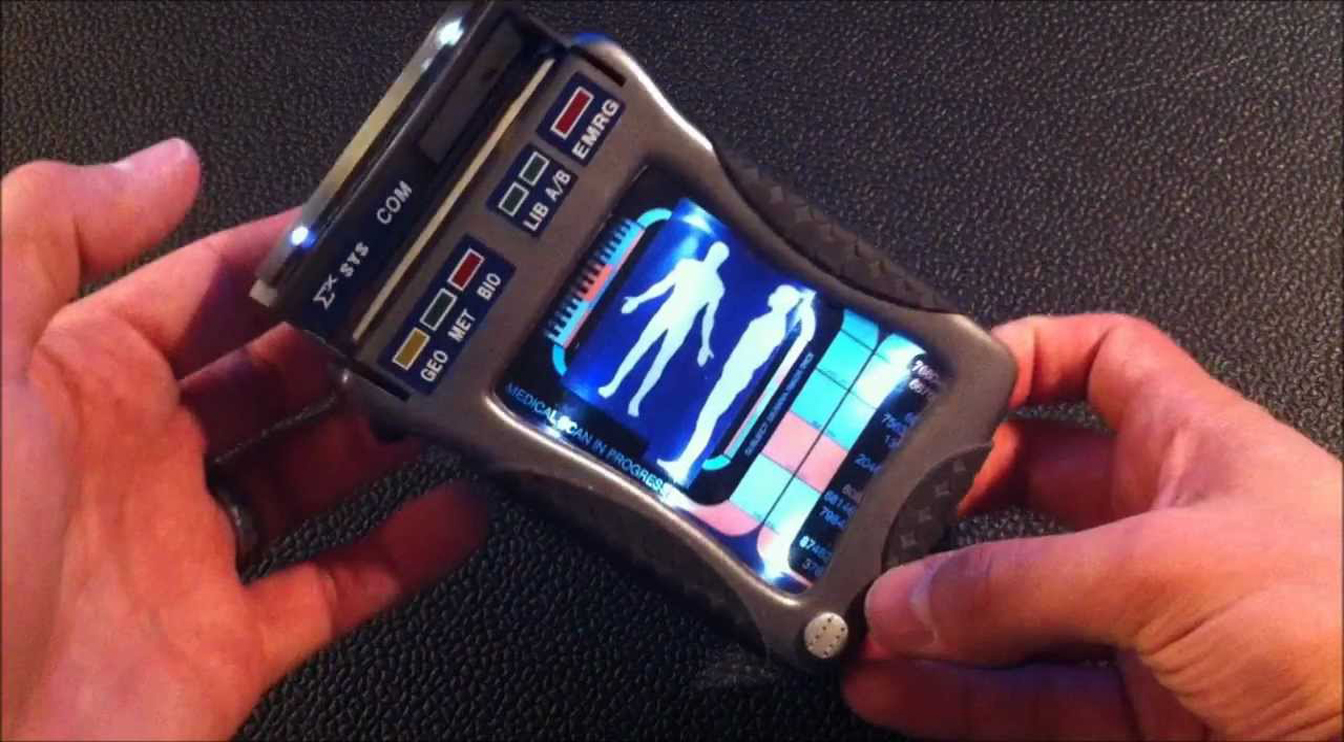
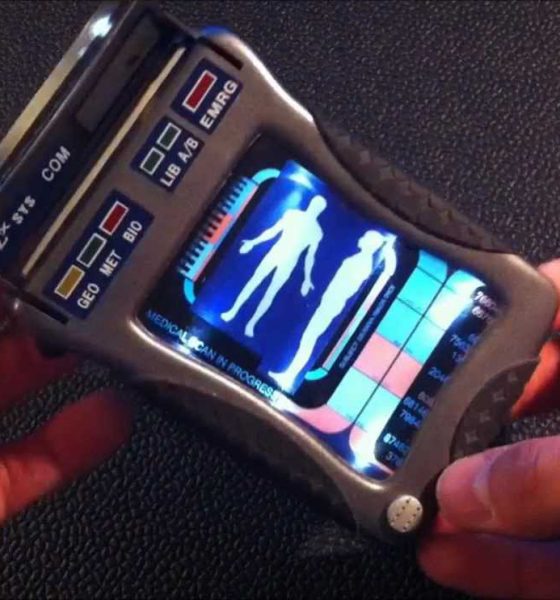
News
Mars travelers can use ‘Star Trek’ Tricorder-like features using smartphone biotech: study
Plans to take humans to the Moon and Mars come with numerous challenges, and the health of space travelers is no exception. One of the ways any ill-effects can be prevented or mitigated is by detecting relevant changes in the body and the body’s surroundings, something that biosensor technology is specifically designed to address on Earth. However, the small size and weight requirements for tech used in the limited habitats of astronauts has impeded its development to date.
A recent study of existing smartphone-based biosensors by scientists from Queen’s University Belfast (QUB) in the UK identified several candidates under current use or development that could be also used in a space or Martian environment. When combined, the technology could provide functionality reminiscent of the “Tricorder” devices used for medical assessments in the Star Trek television and movie franchises, providing on-site information about the health of human space travelers and biological risks present in their habitats.
Biosensors focus on studying biomarkers, i.e., the body’s response to environmental conditions. For example, changes in blood composition, elevations of certain molecules in urine, heart rate increases or decreases, and so forth, are all considered biomarkers. Health and fitness apps tracking general health biomarkers have become common in the marketplace with brands like FitBit leading the charge for overall wellness sensing by tracking sleep patterns, heart rate, and activity levels using wearable biosensors. Astronauts and other future space travelers could likely use this kind of tech for basic health monitoring, but there are other challenges that need to be addressed in a compact way.
The projected human health needs during spaceflight have been detailed by NASA on its Human Research Program website, more specifically so in its web-based Human Research Roadmap (HRR) where the agency has its scientific data published for public review. Several hazards of human spaceflight are identified, such as environmental and mental health concerns, and the QUB scientists used that information to organize their study. Their research produced a 20-page document reviewing the specific inner workings of the relevant devices found in their searches, complete with tables summarizing each device’s methods and suitability for use in space missions. Here are some of the highlights.
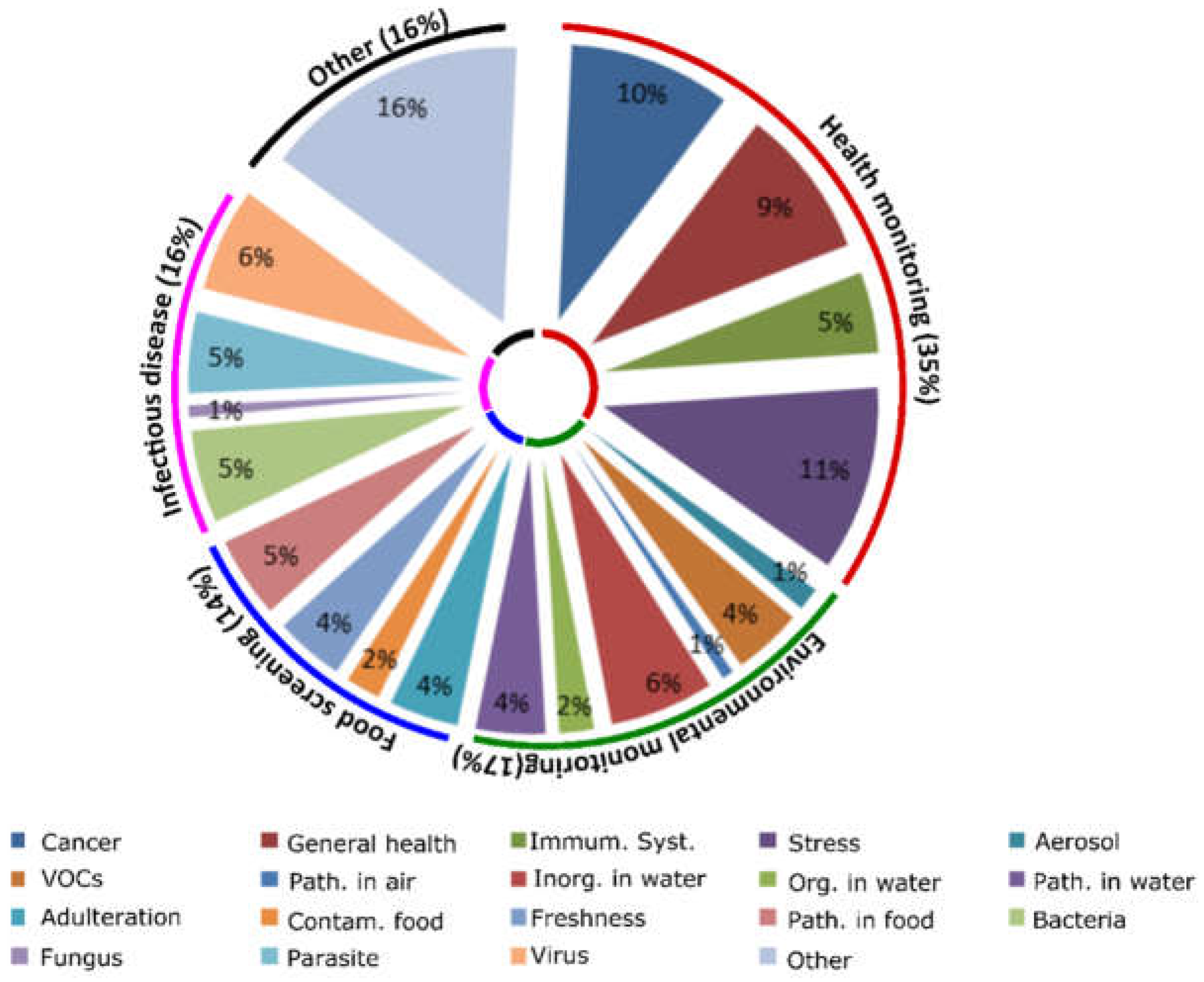
Risks in the Spacecraft Environment
During spaceflight, the environment is a closed system that has a two-fold effect: One, the immune system has been shown to decrease its functionality in long-duration missions, specifically by lowering white blood cell counts, and two, the weightless and non-competitive environment make it easier for microbes to transfer between humans and their growth rates increase. In one space shuttle era study, the number of microbial cells in the vehicle able to reproduce increased by 300% within 12 days of being in orbit. Also, certain herpes viruses, such as those responsible for chickenpox and mononucleosis, have been reactivated under microgravity, although the astronauts typically didn’t show symptoms despite the presence of active viral shedding (the virus had surfaced and was able to spread).
Frequent monitoring of the spacecraft environment and the crew’s biomarkers is the best way to mitigate these challenges, and NASA is addressing these issues to an extent with traditional instruments and equipment to collect data, although often times the data cannot be processed until the experiments are returned to Earth. An attempt has also been made to rapidly quantify microorganisms aboard the International Space Station (ISS) via a handheld device called the Lab-on-a-Chip Application Development-Portable Test System (LOCAD-PTS). However, this device cannot distinguish between microorganism species yet, meaning it can’t tell the difference between pathogens and harmless species. The QUB study found several existing smartphone-based technologies generally developed for use in remote medical care facilities that could achieve better identification results.
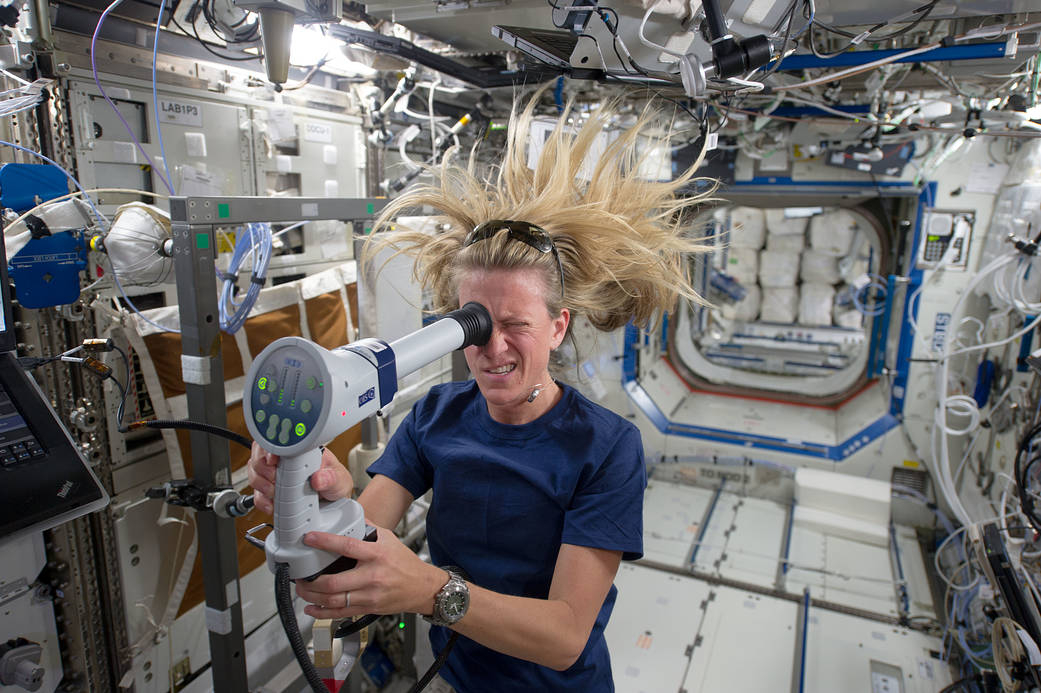
One of the devices described was a spectrometer (used to identify substances based on the light frequency emitted) which used the smartphone’s flashlight and camera to generate data that was at least as accurate as traditional instruments. Another was able to identify concentrations of an artificial growth hormone injected into cows called recominant bovine somatrotropin (rBST) in test samples, and other systems were able to accurately detect cyphilis and HIV as well as the zika, chikungunya, and dengue viruses. All of the devices used smartphone attachments, some of them with 3D-printed parts. Of course, the types of pathogens detected are not likely to be common in a closed space habitat, but the technology driving them could be modified to meet specific detection needs.
The Stress of Spaceflight
A group of people crammed together in a small space for long periods of time will be impacted by the situation despite any amount of careful selection or training due to the isolation and confinement. Declines in mood, cognition, morale, or interpersonal interaction can impact team functioning or transition into a sleep disorder. On Earth, these stress responses may seem common, or perhaps an expected part of being human, but missions in deep space and on Mars will be demanding and need fully alert, well-communicating teams to succeed. NASA already uses devices to monitor these risks while also addressing the stress factor by managing habitat lighting, crew movement and sleep amounts, and recommending astronauts keep journals to vent as needed. However, an all-encompassing tool may be needed for longer-duration space travels.
As recognized by the QUB study, several “mindfulness” and self-help apps already exist in the market and could be utilized to address the stress factor in future astronauts when combined with general health monitors. For example, the popular FitBit app and similar products collect data on sleep patterns, activity levels, and heart rates which could potentially be linked to other mental health apps that could recommend self-help programs using algorithms. The more recent “BeWell” app monitors physical activity, sleep patterns, and social interactions to analyze stress levels and recommend self-help treatments. Other apps use voice patterns and general phone communication data to assess stress levels such as “StressSense” and “MoodSense”.
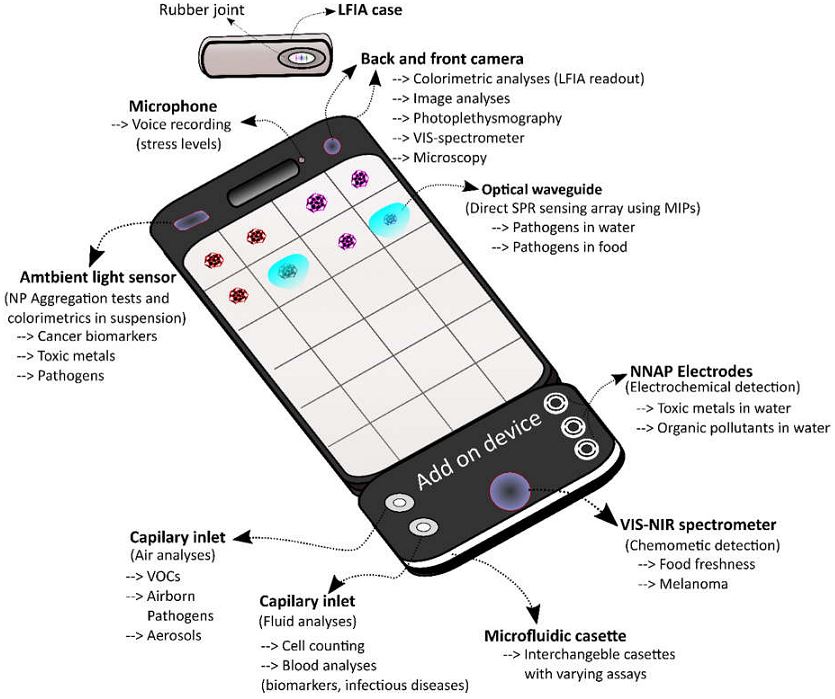
Advances in smartphone technology such as high resolution cameras, microphones, fast processing speed, wireless connectivity, and the ability to attach external devices provide tools that can be used for an expanding number of “portable lab” type functionalities. Unfortunately, though, despite the possibilities that these biosensors could mean for human spaceflight needs, there are notable limitations that would need to be overcome in some of the devices. In particular, any device utilizing antibodies or enzymes in its testing would risk the stability of its instruments thanks to radiation from galactic cosmic rays and solar particle events. Biosensor electronics might also be damaged by these things as well. Development of new types of shielding may be necessary to ensure their functionality outside of Earth and Earth orbit or, alternatively, synthetic biology could also be a source of testing elements genetically engineered to withstand the space and Martian environments.
The interest in smartphone-based solutions for space travelers has been garnering more attention over the years as tech-centric societies have moved in the “app” direction overall. NASA itself has hosted a “Space Apps Challenge” for the last 8 years, drawing thousands of participants to submit programs that interpret and visualize data for greater understanding of designated space and science topics. Some of the challenges could be directly relevant to the biosensor field. For example, in the 2018 event, contestants are asked to develop a sensor to be used by humans on Mars to observe and measure variables in their environments; in 2017, contestants created visualizations of potential radiation exposure during polar or near-polar flight.
While the QUB study implied that the combination of existing biosensor technology could be equivalent to a Tricorder, the direct development of such a device has been the subject of its own specific challenge. In 2012, the Qualcomm Tricorder XPRIZE competition was launched, asking competitors to develop a user-friendly device that could accurately diagnose 13 health conditions and capture 5 real-time health vital signs. The winner of the prize awarded in 2017 was Pennsylvania-based family team called Final Frontier Medical Devices, now Basil Leaf Technologies, for their DxtER device. According to their website, the sensors inside DxtER can be used independently, one of which is in a Phase 1 Clinical Trial. The second place winner of the competition used a smartphone app to connect its health testing modules and generate a diagnosis from the data acquired from the user.
The march continues to develop the technology humans will need to safely explore regions beyond Earth orbit. Space is hard, but it was hard before we went there the first time, and it was hard before we put humans on the moon. There may be plenty of challenges to overcome, but as the Queen’s University Belfast study demonstrates, we may already be solving them. It’s just a matter of realizing it and expanding on it.

Elon Musk
Elon Musk’s X will start using a Tesla-like software update strategy
The initiative seems designed to accelerate updates to the social media platform, while maintaining maximum transparency.

Elon Musk’s social media platform X will adopt a Tesla-esque approach to software updates for its algorithm.
The initiative seems designed to accelerate updates to the social media platform, while maintaining maximum transparency.
X’s updates to its updates
As per Musk in a post on X, the social media company will be making a new algorithm to determine what organic and advertising posts are recommended to users. These updates would then be repeated every four weeks.
“We will make the new 𝕏 algorithm, including all code used to determine what organic and advertising posts are recommended to users, open source in 7 days. This will be repeated every 4 weeks, with comprehensive developer notes, to help you understand what changed,” Musk wrote in his post.
The initiative somewhat mirrors Tesla’s over-the-air update model, where vehicle software is regularly refined and pushed to users with detailed release notes. This should allow users to better understand the details of X’s every update and foster a healthy feedback loop for the social media platform.
xAI and X
X, formerly Twitter, has been acquired by Elon Musk’s artificial intelligence startup, xAI last year. Since then, xAI has seen a rapid rise in valuation. Following the company’s the company’s upsized $20 billion Series E funding round, estimates now suggest that xAI is worth tens about $230 to $235 billion. That’s several times larger than Tesla when Elon Musk received his controversial 2018 CEO Performance Award.
As per xAI, the Series E funding round attracted a diverse group of investors, including Valor Equity Partners, Stepstone Group, Fidelity Management & Research Company, Qatar Investment Authority, MGX, and Baron Capital Group, among others. Strategic partners NVIDIA and Cisco Investments also continued support for building the world’s largest GPU clusters.
News
Tesla FSD Supervised wins MotorTrend’s Best Driver Assistance Award
The decision marks a notable reversal for the publication from prior years, with judges citing major real-world improvements that pushed Tesla’s latest FSD software ahead of every competing ADAS system.

Tesla’s Full Self-Driving (Supervised) system has been named the best driver-assistance technology on the market, earning top honors at the 2026 MotorTrend Best Tech Awards.
The decision marks a notable reversal for the publication from prior years, with judges citing major real-world improvements that pushed Tesla’s latest FSD software ahead of every competing ADAS system. And it wasn’t even close.
MotorTrend reverses course
MotorTrend awarded Tesla FSD (Supervised) its 2026 Best Tech Driver Assistance title after extensive testing of the latest v14 software. The publication acknowledged that it had previously criticized earlier versions of FSD for erratic behavior and near-miss incidents, ultimately favoring rivals such as GM’s Super Cruise in earlier evaluations.
According to MotorTrend, the newest iteration of FSD resolved many of those shortcomings. Testers said v14 showed far smoother behavior in complex urban scenarios, including unprotected left turns, traffic circles, emergency vehicles, and dense city streets. While the system still requires constant driver supervision, judges concluded that no other advanced driver-assistance system currently matches its breadth of capability.
Unlike rival systems that rely on combinations of cameras, radar, lidar, and mapped highways, Tesla’s FSD operates using a camera-only approach and is capable of driving on city streets, rural roads, and freeways. MotorTrend stated that pure utility, the ability to handle nearly all road types, ultimately separated FSD from competitors like Ford BlueCruise, GM Super Cruise, and BMW’s Highway Assistant.
High cost and high capability
MotorTrend also addressed FSD’s pricing, which remains significantly higher than rival systems. Tesla currently charges $8,000 for a one-time purchase or $99 per month for a subscription, compared with far lower upfront and subscription costs from other automakers. The publication noted that the premium is justified given FSD’s unmatched scope and continuous software evolution.
Safety remained a central focus of the evaluation. While testers reported collision-free operation over thousands of miles, they noted ongoing concerns around FSD’s configurable driving modes, including options that allow aggressive driving and speeds beyond posted limits. MotorTrend emphasized that, like all Level 2 systems, FSD still depends on a fully attentive human driver at all times.
Despite those caveats, the publication concluded that Tesla’s rapid software progress fundamentally reshaped the competitive landscape. For drivers seeking the most capable hands-on driver-assistance system available today, MotorTrend concluded Tesla FSD (Supervised) now stands alone at the top.
News
Elon Musk’s Grokipedia surges to 5.6M articles, almost 79% of English Wikipedia
The explosive growth marks a major milestone for the AI-powered online encyclopedia, which was launched by Elon Musk’s xAI just months ago.

Elon Musk’s Grokipedia has grown to an impressive 5,615,201 articles as of today, closing in on 79% of the English Wikipedia’s current total of 7,119,376 articles.
The explosive growth marks a major milestone for the AI-powered online encyclopedia, which was launched by Elon Musk’s xAI just months ago. Needless to say, it would only be a matter of time before Grokipedia exceeds English Wikipedia in sheer volume.
Grokipedia’s rapid growth
xAI’s vision for Grokipedia emphasizes neutrality, while Grok’s reasoning capabilities allow for fast drafting and fact-checking. When Elon Musk announced the initiative in late September 2025, he noted that Grokipedia would be an improvement to Wikipedia because it would be designed to avoid bias.
At the time, Musk noted that Grokipedia “is a necessary step towards the xAI goal of understanding the Universe.”
Grokipedia was launched in late October, and while xAI was careful to list it only as Version 0.1 at the time, the online encyclopedia immediately earned praise. Wikipedia co-founder Larry Sanger highlighted the project’s innovative approach, noting how it leverages AI to fill knowledge gaps and enable rapid updates. Netizens also observed how Grokipedia tends to present articles in a more objective manner compared to Wikipedia, which is edited by humans.
Elon Musk’s ambitious plans
With 5,615,201 total articles, Grokipedia has now grown to almost 79% of English Wikipedia’s article base. This is incredibly quick, though Grokipedia remains text-only for now. xAI, for its part, has now updated the online encyclopedia’s iteration to v0.2.
Elon Musk has shared bold ideas for Grokipedia, including sending a record of the entire knowledge base to space as part of xAI’s mission to preserve and expand human understanding. At some point, Musk stated that Grokipedia will be renamed to Encyclopedia Galactica, and it will be sent to the cosmos.
“When Grokipedia is good enough (long way to go), we will change the name to Encyclopedia Galactica. It will be an open source distillation of all knowledge, including audio, images and video. Join xAI to help build the sci-fi version of the Library of Alexandria!” Musk wrote, adding in a later post that “Copies will be etched in stone and sent to the Moon, Mars and beyond. This time, it will not be lost.”








